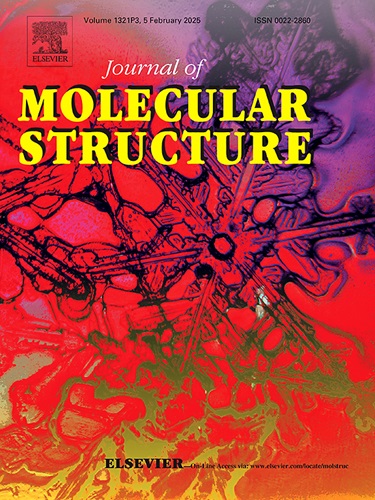开发热稳定的CuO/DPC/PVC纳米复合薄膜,用于柔性紫外线屏蔽和介电应用
IF 4
2区 化学
Q2 CHEMISTRY, PHYSICAL
引用次数: 0
摘要
这项工作的重点是开发用于光电器件和紫外线和蓝光屏蔽应用的新型有机纳米复合材料(ONCs)。采用溶液浇铸法制备了二苯基脲(DPC)和纳米CuO (NPs)改性聚氯乙烯(PVC)薄膜。通过x射线衍射、ATR/傅里叶变换红外光谱、FE-SEM和EDX对膜的结构和化学成分进行了表征。在FT-IR光谱中观察到PVC、DPC和CuO的官能团之间的络合作用。EDX和图谱分析证实了各元素的均匀分布。TGA和DSC(热)分析表明,添加CuO和DPC显著改变了膜的热稳定性、熔化和分解温度。紫外可见光谱分析表明,添加CuO和DPC是PVC阻挡紫外线和蓝光的必要条件。对于直接跃迁,PVC的直接带隙结构可以从5.15 eV调节到3.0 eV,对于间接跃迁,可以从4.9 eV调节到2.4 eV。PVC的光学参数值取决于DPC/CuO的加入量。这些添加剂显著提高了材料的相对介电常数和电导率。对介电模量和Cole-Cole图的研究表明,这些薄膜的导电不服从德拜模型。在结构特征、热学和光学参数、介电性能和电导率方面的显著改进表明,制备的ONC薄膜是介电和光电子应用的最佳候选者,以及需要紫外线/蓝光屏蔽和热稳定性的应用。本文章由计算机程序翻译,如有差异,请以英文原文为准。
Developing thermally stable CuO/DPC/PVC nanocomposite films for flexible UV shielding and dielectric applications
This work focuses on developing novel organic nanocomposites (ONCs) for optoelectronic devices and UV and blue light shielding applications. Films of polyvinyl chloride (PVC) modified with diphenyl carbazide (DPC) and CuO nanoparticles (NPs) were prepared by a solution-casting approach. The structure and chemical composition of the films were checked by X-ray diffraction, ATR/Fourier transform-infrared (FT-IR) spectroscopy, FE-SEM, and EDX. The CuO and DPC increased the amorphous nature of the films, and the complexation among the functional groups of PVC, DPC, and CuO was observed in the FT-IR spectra. The uniform distribution of all elements was confirmed by EDX and mapping analyses. TGA and DSC (thermal) analyses showed that the films’ thermal stability, melting, and decomposition temperatures are significantly modified upon CuO and DPC addition. UV–vis spectroscopy revealed that the addition of CuO and DPC is essential for PVC to block the UV and blue light. The PVC’s direct bandgap structure can be tuned from 5.15 to 3.0 eV for direct transitions and from 4.9 to 2.4 eV for indirect ones. The values of PVC’s optical parameters depend on DPC/CuO addition. The relative dielectric constant and electric conductivity were improved significantly by these additives. The study of dielectric modulus and the Cole-Cole diagram revealed that the conduction in these films does not obey the Debye model. The significant improvements in the structural features, thermal and optical parameters, dielectric properties, and conductivity indicate that the prepared ONC films are the best candidates for dielectric and optoelectronic applications and utilizations where UV/blue light shielding and thermal stability are required.
求助全文
通过发布文献求助,成功后即可免费获取论文全文。
去求助
来源期刊

Journal of Molecular Structure
化学-物理化学
CiteScore
7.10
自引率
15.80%
发文量
2384
审稿时长
45 days
期刊介绍:
The Journal of Molecular Structure is dedicated to the publication of full-length articles and review papers, providing important new structural information on all types of chemical species including:
• Stable and unstable molecules in all types of environments (vapour, molecular beam, liquid, solution, liquid crystal, solid state, matrix-isolated, surface-absorbed etc.)
• Chemical intermediates
• Molecules in excited states
• Biological molecules
• Polymers.
The methods used may include any combination of spectroscopic and non-spectroscopic techniques, for example:
• Infrared spectroscopy (mid, far, near)
• Raman spectroscopy and non-linear Raman methods (CARS, etc.)
• Electronic absorption spectroscopy
• Optical rotatory dispersion and circular dichroism
• Fluorescence and phosphorescence techniques
• Electron spectroscopies (PES, XPS), EXAFS, etc.
• Microwave spectroscopy
• Electron diffraction
• NMR and ESR spectroscopies
• Mössbauer spectroscopy
• X-ray crystallography
• Charge Density Analyses
• Computational Studies (supplementing experimental methods)
We encourage publications combining theoretical and experimental approaches. The structural insights gained by the studies should be correlated with the properties, activity and/ or reactivity of the molecule under investigation and the relevance of this molecule and its implications should be discussed.
 求助内容:
求助内容: 应助结果提醒方式:
应助结果提醒方式:


